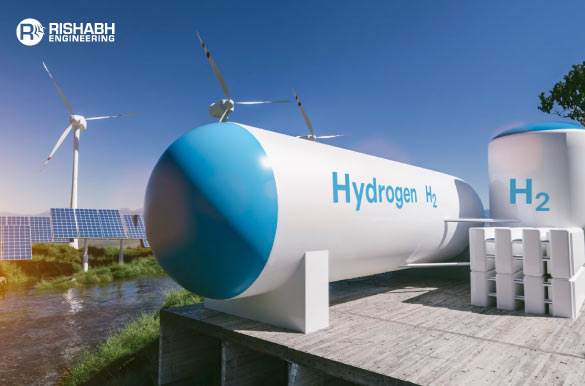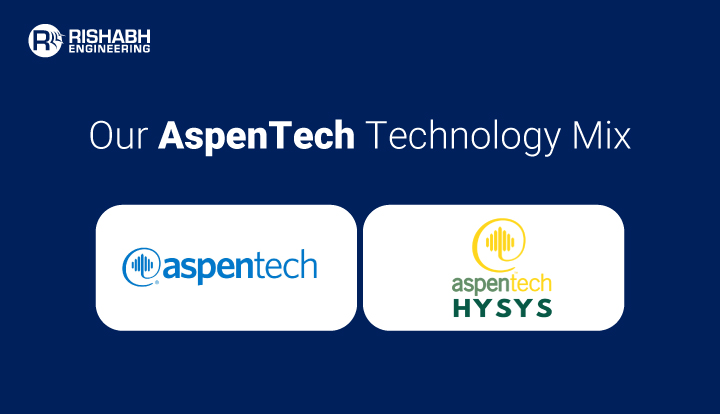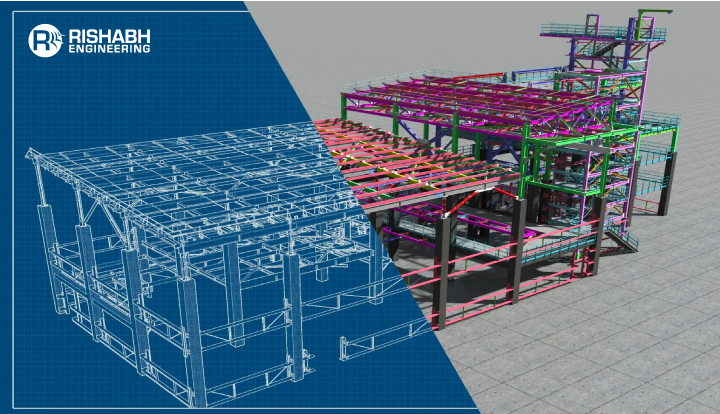
Green Hydrogen Production in 2023
Green Hydrogen has emerged as a promising solution when the world pursues a cleaner and more sustainable alternative. We’re witnessing significant efforts being made in 2023 for green Hydrogen by leveraging renewable energy sources with advanced technologies. This blog will explore the current state of green hydrogen production and Rishabh Engineering’s strides to harness its potential while revolutionizing the energy landscape and addressing climate change challenges.
What is Green Hydrogen?
Green Hydrogen refers to hydrogen gas produced through electrolysis by its constituent elements, Hydrogen (H2) and oxygen (O2). And the electricity used in this process is generated by utilizing renewable energy sources such as wind, solar, hydroelectric, or geothermal power. Applying environmentally friendly aspects for producing Hydrogen suggests using “green” in green Hydrogen. In addition, green Hydrogen offers a carbon-neutral alternative with zero greenhouse gas emissions.

Advancements in Electrolysis Technology
Green hydrogen electrolysis approaches incorporate advanced materials, such as solid oxide electrolyzers and proton exchange membrane electrolyzers. It thus increases the efficiency of hydrogen production while reducing energy consumption. And, while technology advancements are continuously evolving & breakthroughs may have occurred, it is important that you make a note of the most significant ones listed below;
- High-temperature electrolysis: As the name suggests operates at elevated temperatures, typically above 500°C (932°F). Since higher temperatures facilitate faster reactions and lower the electrical input required, this approach helps improve efficiency and reduce energy consumption.
- Solid oxide electrolysis cells (SOEC): Refers to using solid oxide ceramic materials as the electrolyte. It enables better efficiency and lower energy costs even while operating at higher temperatures, up to 800°C to 1000°C (1472°F to 1832°F).
- Proton exchange membrane electrolysis (PEM): This method has gained significant interest because of its higher efficiency and faster response times. It allows only protons to pass through by utilizing a solid polymer electrolyte membrane that reduces gas crossover.
As Green H2 production in 2023 continues to progress, they are likely to play a vital role in the transition of modern industries to a more sustainable and low-carbon energy future.
Renewable Energy Integration
Reports suggest that by 2023, integrating renewable energy sources into green hydrogen production will reach unprecedented levels. The growing capacity of solar and wind power installations worldwide has created an abundant and affordable source of electricity for electrolysis. By utilizing excess renewable energy during off-peak hours, the production of green Hydrogen can be optimized, ensuring a constant hydrogen supply without straining the grid. Additionally, innovative projects have emerged, combining solar or wind farms with on-site electrolysis facilities, forming integrated renewable energy and hydrogen hubs. These hubs effectively maximize the utilization of renewable energy resources by directly converting surplus electricity into green Hydrogen, which can be stored and utilized when renewable energy generation is limited.
Green Hydrogen Production – Scenario
Green hydrogen technology is transitioning from a concept to a tangible reality today. Notably, Europe and the U.S. are experiencing a surge in green hydrogen investments, indicative of its increasing prominence worldwide. A remarkable example is a Norwegian company’s recent announcement of a whopping $4.3 billion investment in a steel plant that includes an integrated hydrogen production facility. Likewise, Finland is making significant strides by initiating the construction of its inaugural green hydrogen plant, supported by a substantial $76 million private investment. These notable developments showcase the expanding acknowledgment of green Hydrogen’s immense potential within the global energy landscape.
Even within India, there’s a potential to bring down the cost of producing green Hydrogen by using low-cost renewable generating plants and cost-curtailment experience gained through solar & wind reverse auctions. Since June 2021, India has witnessed an unprecedented rise in fuel prices, with India’s annual energy import cost of more than USD 123 billion in 2019. Today, more than 82% of this cost is consumed in importing crude oil and natural gas. Further, solar P.V. and wind have revolutionized India’s green energy story in the past decade. Diversification of electricity sources by integrating renewable energy into its grid is helping India achieve the Paris Agreement targets. The country has pledged to achieve 40% installed capacity from renewable energy sources by 2030 and reduce emissions intensity by 33-35% below 2005 levels in its nationally determined commitments to the 2015 Paris Agreement.
Considering the above scenario, Hydrogen is regarded as a sunrise technology for achieving net-zero emission targets as it does not emit GHG upon combustion. Its inherent chemical characteristics, multiple end-uses, and harmony with other fuel and energy carriers make it a strong contender for the clean energy transition apart from electrification, battery storage systems, carbon capture, utilization, and storage (CCUS), bioenergy and more.
Green Hydrogen can easily be converted to green ammonia. It, therefore, assumes vast application for agriculture, fertilizer-producing industries, and refineries. These industries are some of the significant consumers of Hydrogen, utilizing around 6 million tonnes of Hydrogen every year. Furthermore, for India, the Green Hydrogen Policy included incentives for producers of green Hydrogen by allowing them open access to renewable resources and offering up to a 25-year waiver on inter-state transmission charges to green hydrogen producers from the projects commissioned before June 30, 2025. It allows the green hydrogen producers to bank their excess renewable energy with the distribution companies (“DISCOM”) for up to 30 days at applicable banking charges. Additionally, green hydrogen producers can adjust their renewable energy consumption against their Renewable Purchase Obligation (“RPO”) compliance. Any renewable energy utilized beyond this obligation limit can be changed against the RPO compliance of the DISCOM in whose area the project is located.
Project Showcase
We at Rishabh Engineering are instrumental in helping one such customer engaged in the production of hydrogen & ammonia by utilizing renewable energy.
Listed below are a few highlights from the project;
Overview:
Engaged by one of India’s largest solar energy farm owners & operators, we are involved as a design engineering consultant to develop their first ever “Green Hydrogen” Plant in India with a 200 NM3/hr capacity.
Project Scope:
Our scope involves detailed engineering of the BoP & technology integration supplied by the Electrolyser OEM and various packages offered by the OEM, including process compressed air packages, fire fighting systems, and more. Further, it requires everything from strategy to detailed engineering (including mechanical, piping, civil & structural, electrical, and instrumentation).
1. Layout Development
- Hazardous Area Classification
- Utility Consumption Summary and UID
2. Extended basic & detailed engineering
- Mechanical:
– Preparation of Mechanical Datasheet and RFQ for;
1) Buffer tanks
2) Various Packages such As Cooling tower, D.M., Compressor etc. - Piping:
– Developing 3D Model
– Preparation of Plot plant considering various statutory requirements and various engineering norms and standard
– Design of Fire Fighting Package for the entire facility - Civil and Structural:
– Finalize Civil design Philosophy based on Soil testing report and Site Contour survey data
– Complete Civil design for the entire Greenfield Site
– Preparation of Civil BOQ and Civil Tender. - Electrical:
– Preparation of Electrical Load list
– Complete electrical design for the entire Greenfield Site
– Preparation of electrical BOQ and electrical tender - Instrumentation:
– Preparation of Instrumentation Index and I-O List
– Control Philosophy with Integration with technology package
– Preparation of electrical BOQ and electrical Tender
3. Integrating technology package
- Review of the Technology Package (Electrolyzer unit) received from the Technology supplier
- Operating & Control Philosophy Preparation and its Integration with Technology Package
4. Technology software & professional support for BOP
5. Usage of renewable hybrid power ( Solar + Wind)
6. Hydrogen storage & filling
7. Statutory Compliance & offline support
Challenges Addressed:
- A Greenfield project with no existing facility available except solar power
- Managing safety requirements during the generation, handling & transportation of Hydrogen & Oxygen at high pressure
- Operating & Control philosophy for BOP & its Integration with the Technology package
Software Technologies Utilized:
- AutoCAD Plant 3D /Cad works: 3D Model Preparation
- Navisworks/Autodesk 2020: 3D Model Review
- AutoCAD, Acrobat Reader: Drafting and Review
- MS Excel: Line list, PMS, MTO
- STAAD.PRO: Structural Analysis
Future of Green Hydrogen - Industrial Applications & Decarbonization:
Green Hydrogen benefits various industrial sectors, including transportation, energy storage, and manufacturing. Hydrogen fuel cells offer a clean and efficient alternative to internal combustion engines in the transportation industry, with zero tailpipe emissions. Using green hydrogen technology for energy storage complements intermittent renewable energy sources, providing a stable and reliable energy supply during periods of low renewable generation.
Opportunities with Green Hydrogen:
- Carbon Reduction: Renewable hydrogen production significantly reduces carbon emissions because the Hydrogen from renewable energy sources has limited/no direct carbon emissions. Thus making it a clean & sustainable alternative to conventional hydrogen production methods.
- Energy Storage: As an energy carrier, Hydrogen can be stored for long periods, helping address the intermittent nature of renewable energy sources like solar & wind. The excess renewable energy can be utilized for hydrogen production during periods of low demand and eventually converted back into electricity as & when needed.
- Integration with Varied Sectors: With integration across different sectors, such as power generation, transportation, and industrial processes, green Hydrogen can be used as fuel for fuel cell vehicles. It would serve as a feedstock for industrial processes & a replacement for natural gas in heating & power generation.
Moreover, industries with high carbon emissions, such as steel and cement production, can use green Hydrogen as a clean substitute for fossil fuels, reducing their environmental impact and contributing to global decarbonization efforts. Adopting Hydrogen as the energy source in these sectors can help countries achieve climate targets while promoting sustainable economic growth.
Green Hydrogen Challenges:
- Cost: At present, the production of green Hydrogen is a little more expensive than conventional hydrogen production methods. The collective operating cost of renewable electricity, electrolysis equipment, and maintenance ultimately contributes to the higher price of green Hydrogen. To solve this green Hydrogen, in conjunction with grid-scale battery storage, can solve this problem.
- Infrastructure: The hydrogen infrastructure in use at present is built around the use of fossil fuels. It needs an overhaul from production to transportation and eventually distribution. And the creation of a robust hydrogen supply chain would require substantial investments and coordination among various stakeholders. It would include the design of electrolysis facilities, hydrogen pipelines, or transport options like liquid hydrogen carriers.
- Scalability: Meeting global energy demands is a significant challenge for scaling up green hydrogen production. Deployment of large-scale electrolysis facilities would require substantial investment while overcoming regulatory barriers.
- Storage and Transportation: With low volumetric energy density, the storage & transportation of Hydrogen is complex. And to ensure safe handling & prevent leakage would require specialized infrastructure & materials.
Final Words
In 2023, the advancements in electrolysis technology are setting the stage for a sustainable & carbon-neutral energy future. It is coupled with integrating renewable energy sources that make green Hydrogen a viable & scalable solution. The ongoing research & development, supportive policies, and strategic collaborations will generate interest among governments, industries, and investors to unlock its full potential. Further, it can help address the world’s most critical challenge – climate change while reducing the current reliance on fossil fuels and paving the path for creating a cleaner and more sustainable world for the next generations.
Seek Help with Catalyzing Green Hydrogen Production?
We can help you embrace the future of clean energy with green Hydrogen while contributing to a sustainable world.
Related Blogs
Related Blogs
Process Modeling & Simulation Using AspenTech Software in Multidisciplinary Engineering
For the ever-evolving world of industrial processes and engineering, the…

